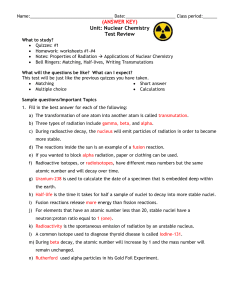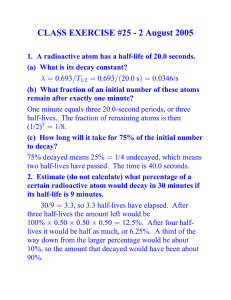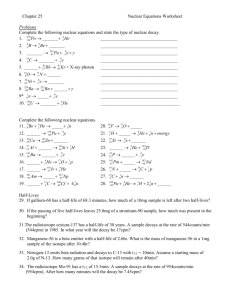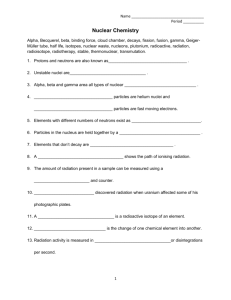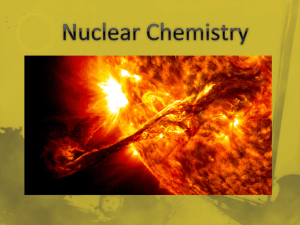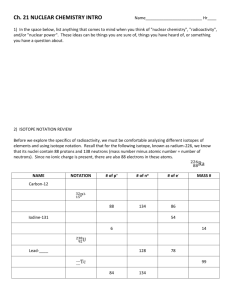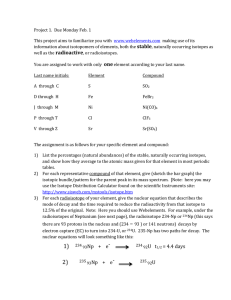Nuclear Chemistry Test Review
advertisement
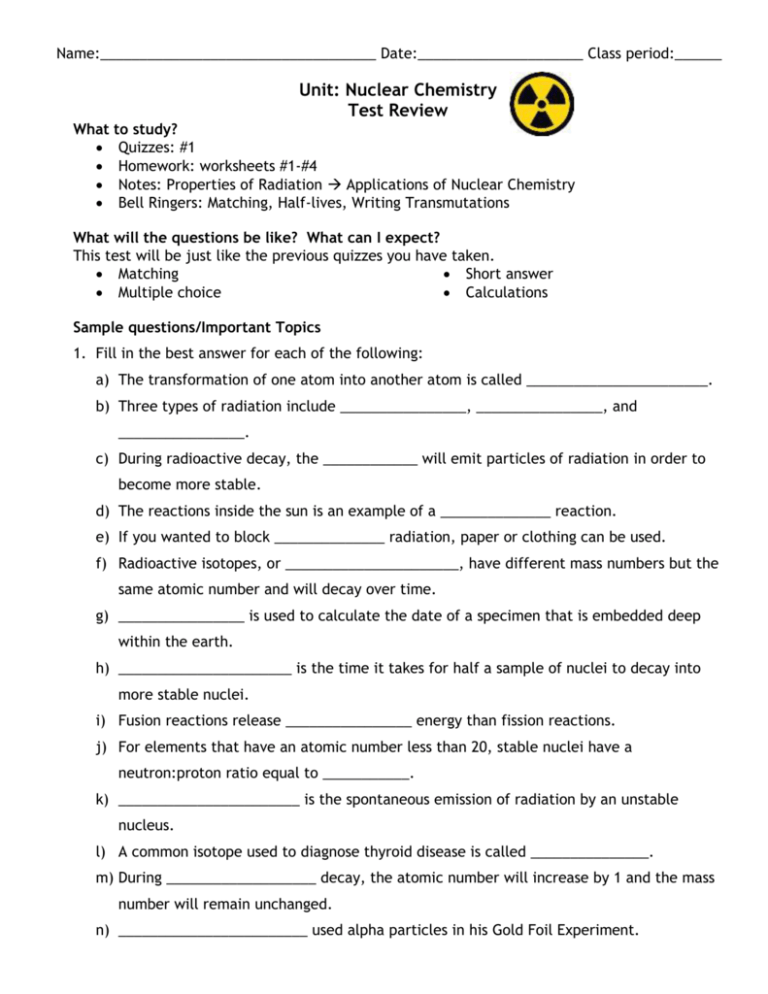
Name:___________________________________ Date:_____________________ Class period:______ Unit: Nuclear Chemistry Test Review What to study? Quizzes: #1 Homework: worksheets #1-#4 Notes: Properties of Radiation Applications of Nuclear Chemistry Bell Ringers: Matching, Half-lives, Writing Transmutations What will the questions be like? What can I expect? This test will be just like the previous quizzes you have taken. Matching Short answer Multiple choice Calculations Sample questions/Important Topics 1. Fill in the best answer for each of the following: a) The transformation of one atom into another atom is called _______________________. b) Three types of radiation include ________________, ________________, and ________________. c) During radioactive decay, the ____________ will emit particles of radiation in order to become more stable. d) The reactions inside the sun is an example of a ______________ reaction. e) If you wanted to block ______________ radiation, paper or clothing can be used. f) Radioactive isotopes, or ______________________, have different mass numbers but the same atomic number and will decay over time. g) ________________ is used to calculate the date of a specimen that is embedded deep within the earth. h) ______________________ is the time it takes for half a sample of nuclei to decay into more stable nuclei. i) Fusion reactions release ________________ energy than fission reactions. j) For elements that have an atomic number less than 20, stable nuclei have a neutron:proton ratio equal to ___________. k) _______________________ is the spontaneous emission of radiation by an unstable nucleus. l) A common isotope used to diagnose thyroid disease is called _______________. m) During ___________________ decay, the atomic number will increase by 1 and the mass number will remain unchanged. n) ________________________ used alpha particles in his Gold Foil Experiment. 2. How do nuclear chain reactions occur? ________________________________________________________________________________ ________________________________________________________________________________ ________________________________________________________________________________ ________________________________________________________________________________ ________________________________________________________________________________ 3. Why is it important that radioactive isotopes used internally for diagnosis or treatment have relatively short half-lives? _______________________________________________________________________________ _______________________________________________________________________________ _______________________________________________________________________________ _______________________________________________________________________________ _______________________________________________________________________________ 4. What happens to an atom with a nucleus that falls outside the band of stability? _______________________________________________________________________________ _______________________________________________________________________________ _______________________________________________________________________________ _______________________________________________________________________________ _______________________________________________________________________________ 5. Which isotope is more stable, hydrogen-1 or hydrogen 3? Explain your choice. _______________________________________________________________________________ _______________________________________________________________________________ _______________________________________________________________________________ _______________________________________________________________________________ _______________________________________________________________________________ 6. If you look a typical nuclear equation, is it possible to tell whether or not the reaction produces gamma radiation? Why or why not? _______________________________________________________________________________ _______________________________________________________________________________ _______________________________________________________________________________ _______________________________________________________________________________ _______________________________________________________________________________ Directions: Show your work for the following calculations. 7. Phosphorus-32 (t1/2 = 14.3days) is used in the treatment of leukemia, among other things. a) The isotope undergoes beta particle decay. Write a balanced equation for this process. b) How many half-lives did the sample go through at the end of 28.6 days? c) If you begin with 4.8g of this radioisotope, what mass will remain after 28.6 days? 8. Iodine-131 is used to treat and diagnose thyroid cancer. The half-life is 8.04 days. a) How many half-lives did the sample go through at the end of 40.2 days? b) If you begin with 2.4g of this radioisotope, what mass will remain after 28.6 days? 9. Copper acetate containing Cu-64 is used to study brain tumors. This isotope has a half-life of 12.7 hours. If you begin with 0.0025mg, what mass in milligrams remains after two halflives? 10. Complete and balance the equations for the following nuclear reactions. 27 4 30 Al He + + ? 13 2 15 P 32 S 16 + 1 0 n 1 1 H + ? ? + 2 1 H 1 0 n + 97 Tc 43 239 Pu 94 + 4 He 2 240 Am 95 + 1 1 H + ? 10 n 11. Write an equation describing the radioactive decay of each of the following radioisotopes. The particle produced is shown in parentheses. (Be sure to include all missing information including symbol, mass number, and atomic number.) a) 50Ti b) 210Po c) 68Ge (beta) (alpha) (positron)


